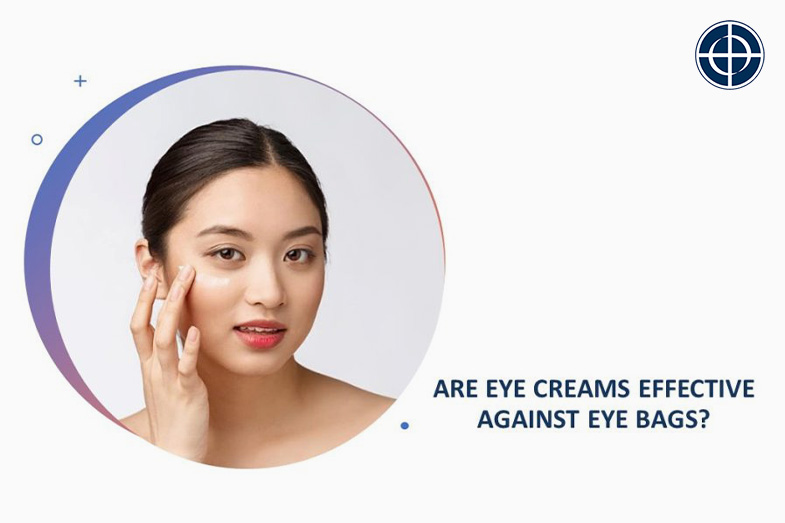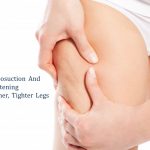In contrast to earlier times, effectively addressing undereye bags is now more accessible. Popular options encompass self-administered remedies like ointments, creams, and eye masks, as well as professional interventions by a doctor, ranging from non-surgical to surgical procedures like eye bag removal. This article explores the effectiveness of eye creams for under-eye bags and whether they can provide long-term results similar to that of eye bag surgery.
How Do Eyebags Develop?
Eye bags are amongst the first signs of ageing due to the progressive changes in the skin sound of the eyes. This skin is fragile and highly delicate, and contains a smaller amount of subcutaneous fat compared to other parts of the body.
As an individual ages, the under-eye skin cells start to divide more slowly, leading to the dermis losing its thickness over time. This is also accompanied by a weakening of the elastin and collagen fibres, which start to loosen and lose their orientation. Visible depressions on the skin surface and volume loss occur as a result. As the skin loses its elasticity, it can no longer retain its moisture and starts to become drier. The oil-secreting glands also become less efficient, and the skin loses its healing capacity. All these factors contribute to the development of wrinkles.
Moreover, this is also accompanied by under-eye swelling and puffiness due to intrinsic and physiological changes in skin structure. Certain lifestyle factors like smoking, drug use, and alcohol can contribute to the formation of under-eye bags. Diets containing a high salt content may also promote the formation of eye bags.
In this scenario, managing under-eye puffiness is not solely linked to ageing; rather, it can pose a daily challenge influenced by lifestyle choices, particularly in terms of dietary habits. Sometimes, puffiness around the eyes may also be triggered by excess rubbing or scratching of the skin. Other factors like lymphatic drainage problems, inflammation, and congestion of the hemodynamic system may also lead to fluid accumulation under the eyes – further exaggerating the eye bags. The lymphatic drainage issues may be due to the gradual reduction in density of the lymphatic networks with ageing, which promotes water accumulation.
Effectiveness of Eye Cream On Eye Bags

Before contemplating eye bag surgery, the initial and most common approach is often the use of eye creams to diminish the appearance of under-eye bags. The categorisation of topical therapies for under-eye areas can be determined by their mode of entry into the skin. This includes:
- Intercellular route – Where the components of the eye cream enter the skin through spaces between the keratinocytes.
- Transcellular Route – Where the components of the eye cream enter the skin through the keratinocytes.
- Tranappendageal Route – Where the components of the eye cream enter the skin through the sebaceous glands, hair follicles, and sweat glands.
What Eye Creams Do
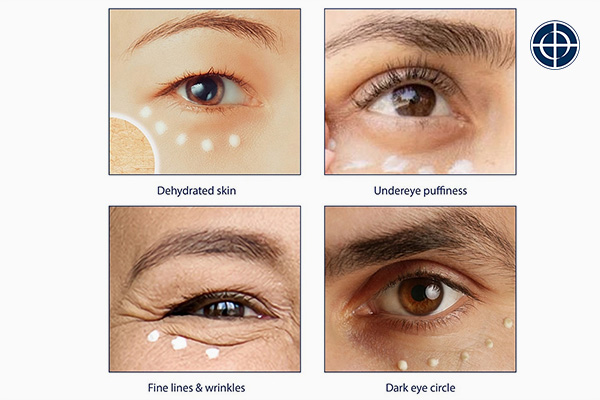
1. Enhance Skin Hydration
Eye creams containing contents like Emu oil can facilitate their penetration into the deeper layers of the skin and provide hydration to these cells. In addition, it prevents the cells from experiencing dehydration due to the abundance of unsaturated fatty acids like Oleic and Linoleic acids. Other than providing hydration to the skin, studies also found it to improve the skin’s ability to act as a barrier, preventing water loss and allowing the skin to stay hydrated for longer. When the participants of the study were clinically assessed individually after using eye creams, they were found to have a progressive improvement in their skin moisturisation and elasticity. This was also associated with a slight improvement in pigmentation.
2. Improve Fine Lines and Wrinkles
Studies have found eye creams containing powerful antioxidants like Vitamin C, Vitamin E, and Caffeine to be effective for under-eye fine lines and wrinkles. The antioxidants promote the removal of harmful radicals from the skin cells, which may decrease oxidative stress levels and improve the skin cells’ overall health.
One such study, which was conducted as a randomised controlled trial, was investigated to assess the effectiveness of eye creams for under-eye bags, fine lines, and wrinkles. Participants were women between the ages of 30 and 70 years, with significant wrinkles around their eyes. They were all asked to apply 500 mg of antioxidant-based eye creams around their eyes for one month and results showed improvement in wrinkles after four weeks of treatment compared to those who received no treatment.
Another component that is often used in eye creams is caffeine. Caffeine is found to have significant vasoconstrictive properties, which means it can cause the construction of blood vessels under the skin. Moreover, it also promotes blood flow, particularly in the capillaries found around the skin of the eyes. This increased blood circulation of the skin cells makes them healthier and helps the skin under the eyes look more rejuvenated.
3. Reduce Under-eye Puffiness
Certain eye creams containing caffeine are often promoted for their ability to improve the appearance of under-eye puffiness. However, the results are usually short-lived. These eye creams contain very high levels of caffeine, which, when applied to the eye skin, causes constriction of the blood vessels. This constriction allows less blood to reach the eye area and improves puffiness by preventing fluid accumulation. Other than caffeine, creams containing menthol or other substances that can cool down the skin may also help temporarily reduce puffiness by helping constrict the blood vessels. But when the effects of these creams wear off, puffiness returns and as such, may not be a solution as effective a long-term treatment like eye bag removal.
4. Lighten Dark Circles
Eye creams cannot treat dark circles or make them disappear; however, they can provide a temporary improvement in their appearance. The eye creams designed for dark circles are often tinted so that they can correct or conceal the pigmentation. However, most individuals have dark circles, which are accentuated due to the hollow anatomy of the under-eye bone structure. Therefore, a fat transfer surgery or dermal fillers may be more effective.
All in all, topical eye creams are often recommended as an additional therapy for concerns and rarely as the primary treatment or therapeutic intervention. The two main ways through which eye creams can help improve the appearance of under-eye bags include their role in promoting hydration and reducing wrinkles and fine lines. Nonetheless, the long-term effectiveness of eye creams for moderate to severe eye bags and dark circles was found to be generally low.
Different Approaches When It Comes to Eye Bag Removal in Singapore
1. Non-Surgical Eye Bag Removal in Singapore
- Dermal Fillers

This works by making the undereye area smoother and filling out any hollow areas created by the bone structure. This causes the under-eye area to be more even and the eye bags to be concealed. Dermal fillers containing hyaluronic acid also provide ample hydration to the skin and stretch it out, which further improves the appearance of fine lines and wrinkles. The filling out of the hollow areas under the eye has the added benefit of getting rid of the dark circles and making the eye area seem brighter. Dermal fillers last from 9 months to a year, after which they need to be reinjected.
- Scarless Eye Bag Removal
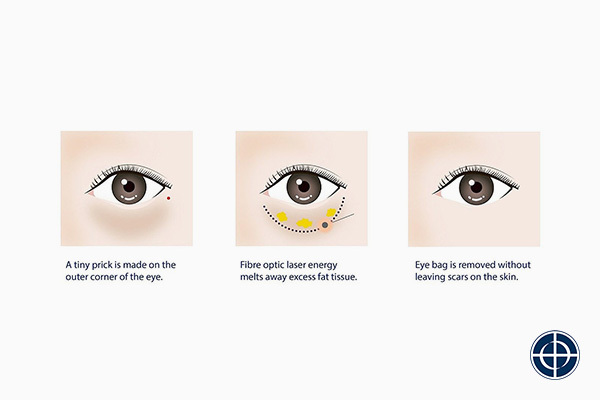
Scarless eye bag removal involves the permanent removal of the excess fat deposits in the under-eye, which causes the eye bags to look more accentuated and protruding. This removal is done using a 0.6-millimeter laser which is directed at entry points and allows the fat and water to be removed. The procedure lasts about 30 to 35 minutes, followed by a short recovery period.
2. Eye Bag Surgery in Singapore
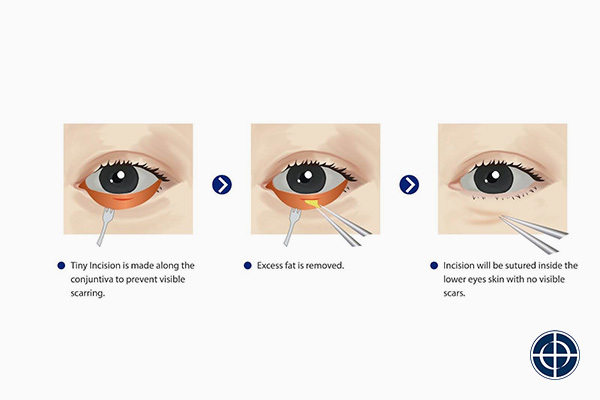
- Transconjunctival Eye Bag Removal Surgery
This approach of eye bag surgery is conducted by removing fat tissues from the inner region of the lower eyelids. The benefit of this surgery is that it does not leave any visible scars on the individual’s face and has a recovery time of 7 to 10 days.
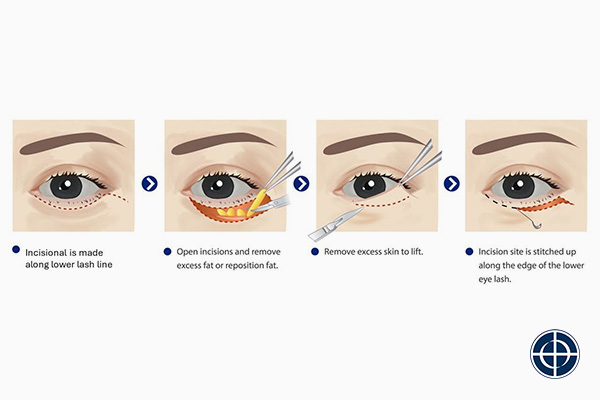
- Incisional Eye Bag Removal Surgery
This form of lower blepharoplasty is conducted by making an incision within the lower lash line, which allows the removal of excess skin and fats accumulated in the eye bags. Incisional eye bag surgery allows for a more even and firmer under-eye area.
Say Goodbye to Eye Bags With Confidence
While eye creams have become a popular approach for the management of different skin concerns, their topical nature makes their effects short-lived. Studies have found eye creams to be effective at providing hydration to the skin and, in turn, correcting fine lines and wrinkles, but they may not be as effective for eye bags and undereye pigmentation.
As such, individuals looking for long-term results often turn to other methods like dermal fillers, scarless eye bag removal, and incisional and transconjunctival eye bag surgery.
If you’re uncertain about your eligibility for eye bag removal in Singapore, don’t hesitate to ask any questions. Our team will guide you through the procedure steps and provide information on what to expect before and after the procedure.

